Violinist Shaham turns to brisk Baroque Bach, recast in modern frame of super-slow videos
Review: “Six Solos for Violin,” a performance of Bach’s sonatas and partitas by violinist Gil Shaham with original films by David Michalek, at Orchestra Hall on March 1. Tour continues to Sonoma, Los Angeles, Santa Barbara and Champaign-Urbana.
By Nancy Malitz
After hearing Bach, there are melodies that linger in the memory, as if the brain is sorting bits to savor in pursuit of its own afterglow. But after listening to the Bach of Gil Shaham on March 1 at Orchestra Hall, there are images that linger, too.
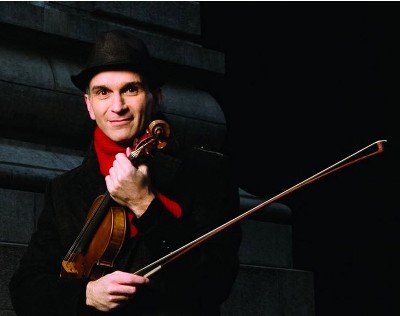 In an intriguing experiment, the American violinist has transformed what is a traditionally solitary, musical performance of Bach’s six unaccompanied violin partitas and sonatas into a collaborative artistic expression with video artist David Michalek. His extreme slow-motion imagery was projected behind Shaham on the stage, sculpting time, and even reversing it, in such a way that fleeting impressions could be savored: A young girl’s turn in the air. Spellbound lovers. Water falling, or is it rising? A dying breath.
In an intriguing experiment, the American violinist has transformed what is a traditionally solitary, musical performance of Bach’s six unaccompanied violin partitas and sonatas into a collaborative artistic expression with video artist David Michalek. His extreme slow-motion imagery was projected behind Shaham on the stage, sculpting time, and even reversing it, in such a way that fleeting impressions could be savored: A young girl’s turn in the air. Spellbound lovers. Water falling, or is it rising? A dying breath.
Collaborative efforts involving video artistry have been with us for a while now. The art form itself is maturing along with the exploration of extreme slow-motion techniques, and Michalek is one of the best. Focus and anticipation are key ingredients, along with the kind of beauty that makes you want to stop dead in your tracks to savor it, which is rather what Michalek enables.
The result can be magical, devastating, even funny. Anyone who has enjoyed the 50-foot tall video faces at Crown Fountain in Millennium Park — a public delight by Catalan artist Jaume Plensa in which viewers watch for minuscule facial cues that water spouts are about to erupt — already has a sense of how compelling the technique can be.
Michalek’s analogous public project, which played unforgettably in the plaza at New York City’s Lincoln Center in 2007 (above), was called “Slow Dancing.” It stretched intricate spins and leaps by professional dancers on giant screens — moves that lasted in real time only a few seconds — into 10-minute escapes from gravity.
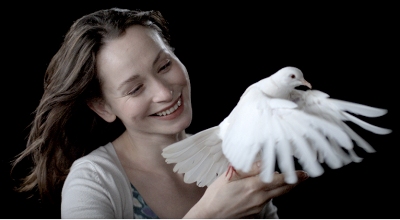 Shaham saw those videos and began a conversation with Michalek that eventually resulted in the Bach collaboration, the best scenes of which are breathtaking visual metaphors for the the essential and often rapturous emotional states suggested by Bach’s music. (Doubtless some in the audience would have preferred knowing in advance that extended passages from the Second Partita in involved nude bodies in motion.) The Chicago performance marked the collaboration’s world premiere, with the artist in attendance and a technician behind the scene to the cue the videos. Subsequent performances are scheduled this month for Sonoma, Los Angeles, and Santa Barbara, and on April 23 in Champaign-Urbana. The tour coincides with the release of his 2-CD set of the audio, which is also available as a download in three digital formats.
Shaham saw those videos and began a conversation with Michalek that eventually resulted in the Bach collaboration, the best scenes of which are breathtaking visual metaphors for the the essential and often rapturous emotional states suggested by Bach’s music. (Doubtless some in the audience would have preferred knowing in advance that extended passages from the Second Partita in involved nude bodies in motion.) The Chicago performance marked the collaboration’s world premiere, with the artist in attendance and a technician behind the scene to the cue the videos. Subsequent performances are scheduled this month for Sonoma, Los Angeles, and Santa Barbara, and on April 23 in Champaign-Urbana. The tour coincides with the release of his 2-CD set of the audio, which is also available as a download in three digital formats.
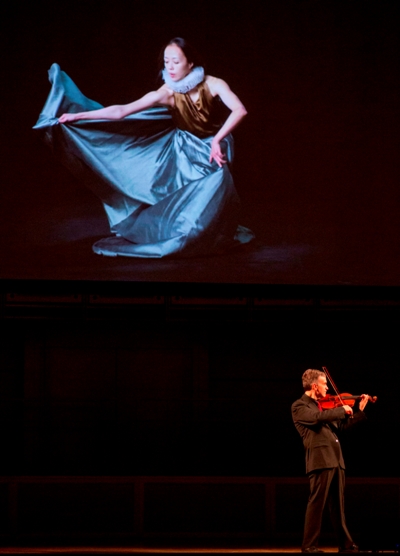 With the video stretching large behind him and a small monitor at his feet, Shaham took an up-tempo approach to the entire cycle, alternating sonata and partita in accordance with the way Bach ordered them. Even without the videos, Shaham’s playing reflected his new way of thinking about the music that is influenced by the modern interest in early 18th-century performance techniques. In an article on the website of his Canary Classical label, he explains that once he fitted out his 1699 Stradivarius with accoutrements more fitting to its own time — gut strings instead of steel, a lower bridge, a different bow with less tension, etc. — the brisker tempos came naturally.
With the video stretching large behind him and a small monitor at his feet, Shaham took an up-tempo approach to the entire cycle, alternating sonata and partita in accordance with the way Bach ordered them. Even without the videos, Shaham’s playing reflected his new way of thinking about the music that is influenced by the modern interest in early 18th-century performance techniques. In an article on the website of his Canary Classical label, he explains that once he fitted out his 1699 Stradivarius with accoutrements more fitting to its own time — gut strings instead of steel, a lower bridge, a different bow with less tension, etc. — the brisker tempos came naturally.
And while one may prefer the elegiac Second Sonata in A Minor and the Second Partita, with its grief-drenched Chaconne in particular, at a slower pace, it is without question that Shaham’s choices made sense in the context of the whole cycle as he presented it. A number of the dance movements were a delight, possessed of a sweet speed and almost weightless grace that Michalek picked up on as well.
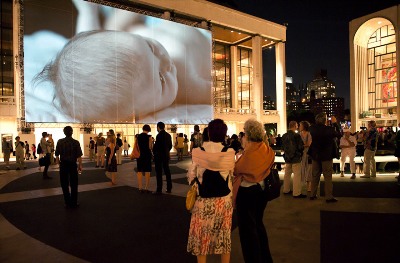 Michalek’s films were selected from hundreds he has made, some also used in other projects. The level of sustained silence in the hall at the height of Chicago’s coughing season suggested that the audience was strongly engaged. The Sonata No. 1 opens with a delicate nativity scene (from the same footage as at right), Sonata No. 2 with an unforgettable death bed caress, Sonata No. 3 with a woman contemplating a dove about to take flight from her hand. There are several (near) still-lifes, perhaps one too many, but it fits the melancholy nature of Sonata No. 2 to have Shaham play a headlong fugue while the camera fixes on a skull, a crystal ball and an hourglass through which the sand slowly trickles.
Michalek’s films were selected from hundreds he has made, some also used in other projects. The level of sustained silence in the hall at the height of Chicago’s coughing season suggested that the audience was strongly engaged. The Sonata No. 1 opens with a delicate nativity scene (from the same footage as at right), Sonata No. 2 with an unforgettable death bed caress, Sonata No. 3 with a woman contemplating a dove about to take flight from her hand. There are several (near) still-lifes, perhaps one too many, but it fits the melancholy nature of Sonata No. 2 to have Shaham play a headlong fugue while the camera fixes on a skull, a crystal ball and an hourglass through which the sand slowly trickles.
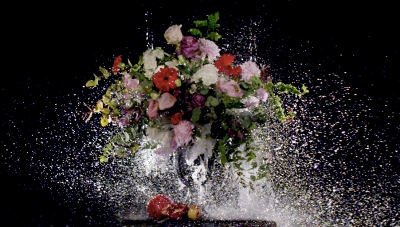 In the way that still-life painters like to play with the reflective qualities of glass, Michalek meditates drolly on aspects of water, first flooding a flower arrangement in the Sonata No. 3 and then un-flooding it in a frame reversal at the end of the cycle. An obvious trick, perhaps, but one that brought whoops and smiles from my section of the balcony. The final films of the cycle dwelt much on children playing musical instruments, exquisite and charming if repetitive; and the extended Chaconne of the Second Partita needed something far more potent to underscore its deeply personal path to transcendence than the ritual formality of a kimono-clad dancer.
In the way that still-life painters like to play with the reflective qualities of glass, Michalek meditates drolly on aspects of water, first flooding a flower arrangement in the Sonata No. 3 and then un-flooding it in a frame reversal at the end of the cycle. An obvious trick, perhaps, but one that brought whoops and smiles from my section of the balcony. The final films of the cycle dwelt much on children playing musical instruments, exquisite and charming if repetitive; and the extended Chaconne of the Second Partita needed something far more potent to underscore its deeply personal path to transcendence than the ritual formality of a kimono-clad dancer.
But this is Bach, who will go on forever, and there is time. The Shaham-Michalek collaboration falls in the tradition of “The Tristan Project” which the video artist Bill Viola and director Peter Sellars worked and re-worked through several seasons. The “Six Solos for Violin” implies a future of creative re-imagining in the recital genre.

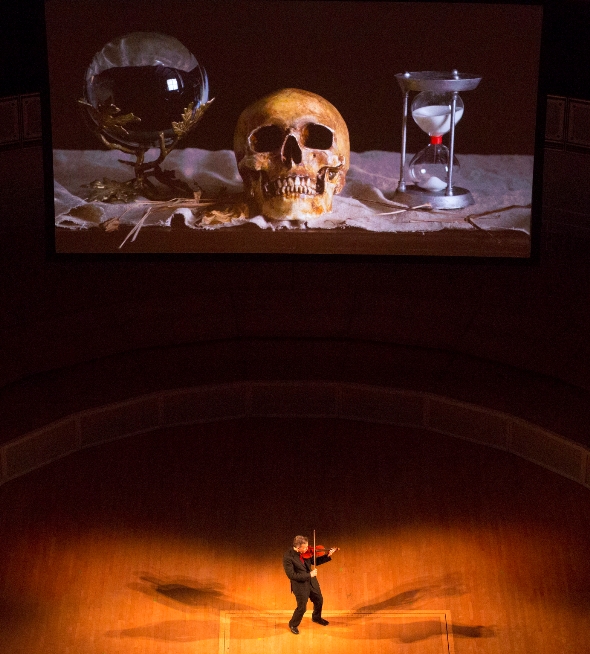

After seeing Gil Shaham perform a masterful and unique rendition of Bach’s solo violin work at Sonoma State University, I can only say that David Michalek’s films almost ruined the experience.
For me, Bach’s solo violin work represents the pinnacle of human art. It exists as complete to itself. It needs no counterpart. The videos were distracting, too bright, and laughable. Michalek’s hubris is matched only by the ridiculous content of his subject matter. Why would I want to watch young children play violin in slow motion while Gil Shaham is playing Bach right in front of me? Why do I want to watch flowers un-break in reverse while listening to the Partita in E? Why, when watching Bach, did I have to wrestle my attention away from absurd images of doves, skulls, and dancers to focus on the music? Why is my ability to hone my attention put to test when a 50 foot picture of Lili Taylor takes me on a mental path down the plot of High Fidelity? I had to close my eyes for the entire last third of the concert. If you want to put videos on YouTube and set them to Bach’s work, go right ahead. Don’t subject me to it at a recital.
To say that this experiment is “magical” is laughable; to say it is “devastating” is true only in its effect on the experience of the audience. If this is the future of the recital genre, Bach save us all.
Had Bach wanted a staged element to his music, he would have provided one. He did not.
After seeing Gil Shaham perform a masterful and unique rendition of Bach’s solo violin work at Sonoma State University, I can only say that David Michalek’s films almost ruined the experience.
For me, Bach’s solo violin work represents the pinnacle of human art. It exists as complete to itself. It needs no counterpart. The videos were distracting, too bright, and laughable. Michalek’s hubris is matched only by the ridiculous content of his subject matter. Why would I want to watch young children play violin in slow motion while Gil Shaham is playing Bach right in front of me? Why do I want to watch flowers un-break in reverse while listening to the Partita in E? Why, when watching Bach, did I have to wrestle my attention away from absurd images of doves, skulls, and dancers to focus on the music? Why is my ability to hone my attention put to test when a 50 foot picture of Lili Taylor takes me on a mental path down the plot of High Fidelity? I had to close my eyes for the entire last third of the concert. If you want to put videos on YouTube and set them to Bach’s work, go right ahead. Don’t subject me to it at a recital.
To say that this experiment is “magical” is laughable; to say it is “devastating” is true only in its effect on the experience of the audience. If this is the future of the recital genre, Bach save us all.
Had Bach wanted a staged element to his music, he would have provided one. He did not.